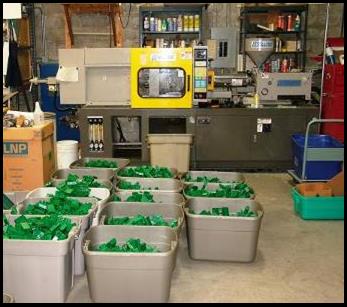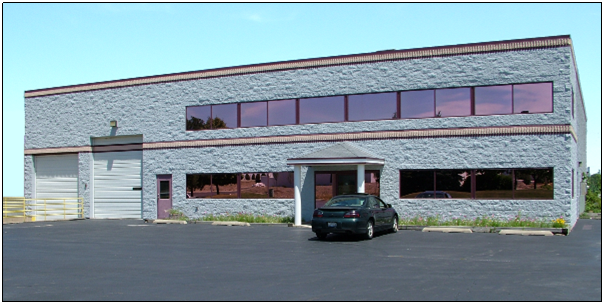
|
In-House Molding of Cases for the TORTOISE™ Slow Motion Switch Machine |
|
Circuitron’s History |

|
Circuitron, Inc., and Progressive Model Design, 211 RocBaar Dr., Romeoville, IL 60446 |
|
CIRCUITRON was formed in late 1977 when Steve Worack picked up a model railroading magazine (after a break in modeling for his college years) and thumbing through the pages, he realized that there were precious few (none) companies providing state of the art electronics for the industry. Steve had been a modeler from age 4 and had actively pursued the hobby up through high school. Having already tired of working in the “real” world as an electronics tech/engineer (after a single year!), he decided to combine his background in modeling with his experience in electronics and that led him to his decision to develop a line of products for the model industry. The company was incorporated a few years later. We initially operated out of Steve’s grandmother’s basement with some help from both his parents. His mother enjoyed assembling and soldering the products and his father stopped on his way home from work to process the orders and keep the “books”. The initial product line was limited to roof-top locomotive strobes, a grade crossing detection unit (DT-1), grade crossing flasher (FL-2) and a hand-held throttle (later discontinued). Sales were limited to local hobby shops and flea markets. Revenues were meager, but the work was enjoyable and rewarding, and by the time the line was picked up by Wm. K. Walthers two years later, Steve had spent many hundreds of hours at the corner restaurant drinking coffee and working on designs and had developed about 10 more circuits and a dozen and a half accessories. National advertising in Model Railroader and Railroad Model Craftsman magazines had begun in 1978 and our sales were now nationwide. In 1979, we attended our first national trade show, and although our exhibit was somewhat pathetic, we made up for it in enthusiasm. The line was well received and our orders, sales and recognition grew steadily throughout the early 80’s. The SNAPPER™ twin-coil switch machine power supply, automatic reverse circuits, block detectors and 3 more grade crossing detectors had now been designed by Steve and added to the line. We now had six or seven domestic distributors and letters from happy modelers using our products were now arriving on a regular basis. In 1983, we made the big move out of the basement and into a tiny 1100 square feet of manufacturing space in Berwyn, IL. We purchased our first computer and for the first time, we employed assemblers and packers outside of family members. It was also around this time that the Scale Scenics™ Division was formed to market white metal and styrene kits of construction equipment.
In 1984, Steve designed and built the prototype of the TORTOISE™ Slow Motion Switch Machine with some help from his Scale Scenics™ partner, Jim Allen. Funding was secured through the Small Business Administration (SBA) to finance the cost of the injection molding tooling and within a year, production had begun. The TORTOISE™ is unique in the industry in being the first (and only) low-current, stall-motor mechanism which was specifically designed to be a model railroad switch machine. The new features of this machine resulted in a US patent for the design issued to Steve and CIRCUITRON the following year. Although our patent expired 18 years after it was filed, the TORTOISE has become well enough known to be recognized by its SHAPE alone. And the US Patent Office agreed by issuing a trademark to CIRCUITRON based solely on the shape of the TORTOISE. This means that no one can make a switch machine that even LOOKS like the TORTOISE without infringing on our intellectual property. In 1988, CIRCUITRON was selected by Santa Fe Industries as the primary contractor to completely renovate the existing 3,000 square foot ‘O’ Scale layout at Chicago’s Museum of Science and Industry. The Progressive Model Design division of CIRCUITRON was formed. This layout was a favorite of museum visitors from all over the world, but decades of constant running and maintenance had taken their toll. This 2 year project included all new locomotives and rolling stock, completely refurbished scenery, many new structures, a complete new control console that simulated a modern dispatching tower complete with wheelchair accessible ramps for the museum visitors, 3+ miles of new wiring, and a new computer controlled electronics system that was capable of operating all the train movements, signals and block controls for up to 6 independent trains. Software to operate this system was written by Dr. Bruce Chubb along with additions written by Steve. Advanced for its day, and pre-Windows, the software was written in Microsoft’s QuickBasic and was compiled into an executable file to run the layout. In addition, the operating hump yard (unique in its design) was completely redesigned by Steve and was also placed under computer control. Stock CIRCUITRON products were utilized as well as I/O components from Dr. Chubb’s CMRI line along with some custom built electronics by CIRCUITRON. Sadly, this magnificent O scale layout was removed in 2004 to make room for an even more ambitious HO scale project. By 1991, we had seriously outgrown our Berwyn facilities and we entered into an agreement with a long-time friend to jointly design and build a new 11,000 square foot industrial building to house both our businesses. Starting with sketches on a napkin (Really!), we refined and honed the design into something ideal for both our needs. Financing was secured and acting as our own general contractors, we brought the building in under budget. The building was completed in 8 months, and CIRCUITRON moved operations to Romeoville, IL in July of 1992. With its pillared entrance, gray split-faced block and two floors of light rose colored mirrored glass windows, it is, without a doubt, the prettiest building in the industrial park. We’re very proud to be here.
|
|
This additional space allowed us to pursue a couple of other goals. In 1994, CIRCUITRON became an independent plastics processor when we purchased a brand new 55 ton injection molding machine, chiller and sprue grinder. The ability to mold our own parts for the TORTOISE™ has streamlined our production and allowed us to hold costs down. It also paved the way for a number of new plastics projects which have been and are currently under development. |
|
The additional space in the new building also allowed us to get back into model building, something we had not had much opportunity to do during the previous few years. In 1995, Progressive Model Design® (PMD, a division of CIRCUITRON, Inc.) was registered and trademarked to do custom layout and diorama building for businesses, museums and individuals. With some of the country’s finest modelers and artists on staff, the quality of work coming out of our Romeoville studio is exceptional. Some of PMD’s early projects included the 20 foot long display layout of CIRCUITRON’s that has been a crowd pleaser at trade shows all over the country and a large overhead G Scale layout simulating Chicago’s Elevated Transit system (the ‘EL’) which was installed in the Big Downtown restaurant inside Chicago’s famous Palmer House Hilton. The custom painted structure for this layout was all hand-fabricated and assembled from extruded ABS plastic I-beams and other members and then hung from the ceiling of the restaurant. Two trains ran around a double track continuous outside loop, stopping periodically while two other trains traversed point to point tracks across the width of the restaurant. Sadly. the trains were removed and the restaurant demolished to make way for underground parking in late 2007. Also in 1995, CIRCUITRON introduced the MITEY LITES™ line of miniature lamps and LEDs. Working closely with our supplier overseas, we continue to expand the line and have developed the highest quality and widest range of sub-mini lamps and LEDs in the model railroad market. In July of 2000, our cabinet-maker partner dissolved his business and sold us his half of the building. After completely refurnishing the wood shop with all new equipment, PMD expanded to occupy the extra 5,200 square feet. We now had room to build substantial sized layouts for large homes, businesses and museums. We also purchased the equipment and installed a machine shop with CNC capability and a Laser Engraver/Cutter. Have a look at the PMD web-site at www.ProgressiveModelDesign.com. A number of our projects have been profiled in the major model magazines. Watch for photos of some of our projects in upcoming issues. Today, CIRCUITRON continues to expand our product lines as well as refining and improving existing products. We now have over 15 distributors in the U.S. and eight foreign countries and our products are commonly found in 1000’s of hobby shops around the world. We now have close to 250 part numbers in our line (over 260 if you count Scale Scenics), and we are always working on new products soon to be released. Our customer support is legendary and we have thousands of friends throughout the modeling world. As always, we remain committed to being the finest manufacturer of Model Railroad electronics and accessories, now and on into the 21st century. HOME |